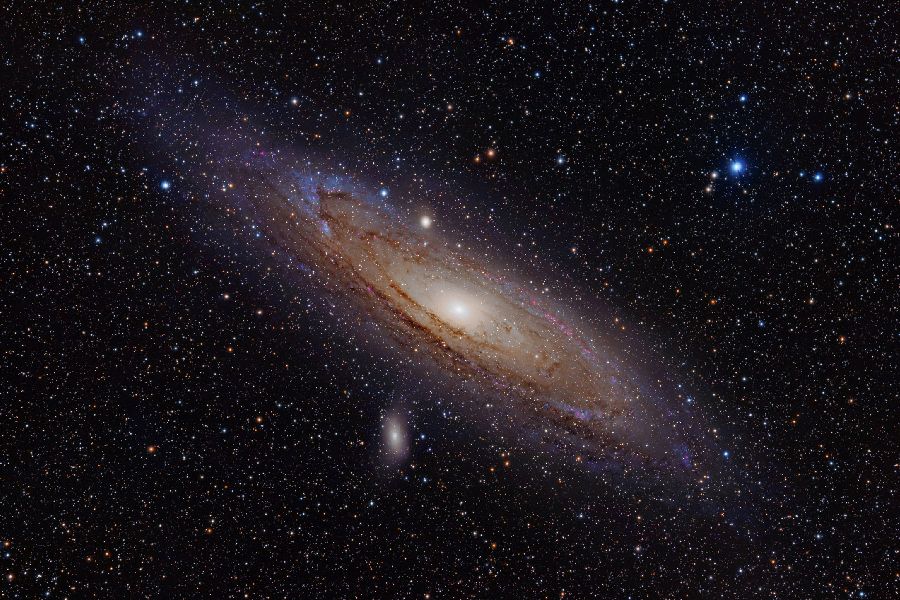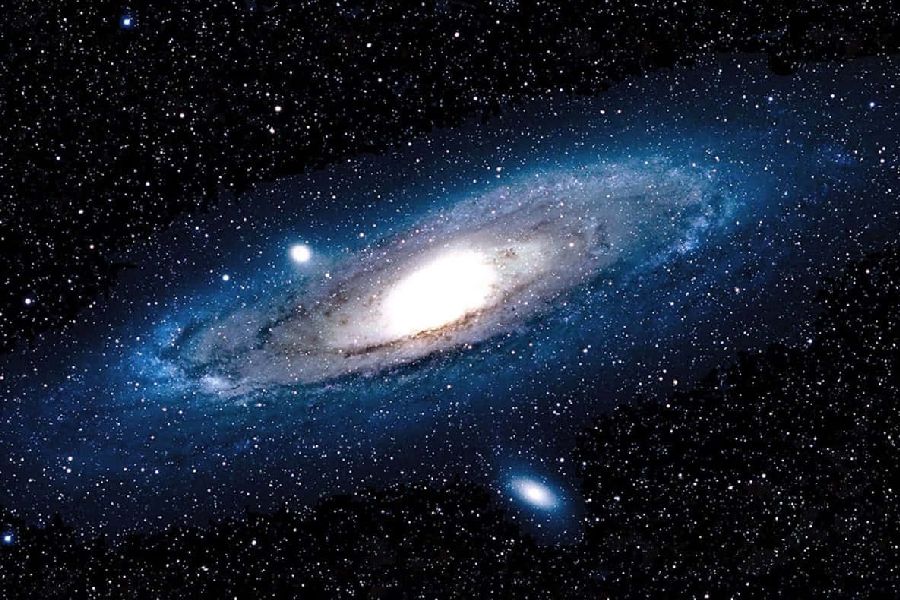There are massive, egg-shaped luminous entities captured in deep-space images. These intriguing formations are known as elliptical galaxies, rerapresenting one of the three primary galaxy types. But what is an elliptical galaxy?
We’ll explore key traits that define ellipticals, including their appearance, interior structure, stellar makeup, and history. Understanding elliptical galaxy characteristics unveils clues into galactic formation and evolutionary processes from early epochs of the universe.
We will also reveal their significance across the cosmos and what they tell us about our galactic zoo. Get ready to be amazed by these quiescent yet fascinating elliptical galaxy facts!
What Is An Elliptical Galaxy?
An elliptical galaxy boasts an oval shape, distinguishing it from spiral galaxies that exhibit distinct arms. In contrast to the organized structures of spirals, elliptical galaxies possess a more symmetric appearance. These galaxies predominantly consist of aging stars with minimal ongoing star formation.
Elliptical galaxies span various sizes, encompassing small dwarf ellipticals to colossal giants. Their classification hinges on the degree of elongation, ranging from nearly spherical (E0) to highly elongated (E7). This elongation-based categorization sheds light on the diverse nature of elliptical galaxies.
Various factors, including mergers and interactions with neighboring galaxies, intricately shape the formation and evolution of these galaxies. These influences contribute significantly to the varied appearances and distinctive properties observed within elliptical galaxies.

Characteristics of Elliptical Galaxies
Smooth and structureless shape
Elliptical galaxies, characterized by their smooth, oval, or spherical shape, lack prominent structures such as spiral arms. In contrast to actively star-forming spiral galaxies, ellipticals consist predominantly of old, cool red giant stars aged over 10 billion years.
This composition earns them the moniker “red and dead”. Due to minimal ongoing star formation, ellipticals harbor less interstellar gas and dust than spirals.
Giant, ghostly galaxies
Giant elliptical galaxies, characterized by their colossal egg-shaped halos, harbor an astonishing assembly of over a trillion ancient stars. These celestial giants not only boast a sheer magnitude in size but also conceal massive black holes within their dense centers, each with a mass ranging from millions to billions of times that of our Sun.
The presence of these colossal black holes plays a pivotal role in shaping the evolutionary trajectory of these galaxies. It adds an intriguing dimension to their cosmic narrative.
Stellar fossils from the early universe
Ellipticals, acting as living fossils from the early universe, originated when they formed most of their stars. These celestial bodies offer valuable insights into the assembly of galaxies billions of years in the past.
Their simple and uncomplicated structure sets ellipticals apart from their spiral and irregular counterparts in our galactic world. Furthermore, their predominantly elderly stellar population further distinguishes them in the cosmic landscape.
Shape and Size
Distinctive structure
Elliptical galaxies get their name from their smooth, oval, or spherical shape. Unlike spiral galaxies, they lack spiral arms, a central bulge, and bar structures. Spiral galaxies exhibit these distinctive structures.
These elliptical galaxies come in various sizes, from small dwarf ellipticals to massive giants. Their structure varies in ellipticity and is defined by the Sersic profile, which shows a decline in light intensity from the bright core.
Observations of these galaxies reveal shell-like structures and ripples, indicating past merger events. Additionally, the presence of multiple nuclei suggests these historical events. These occurrences highlight a unique form tailored to accommodate ancient stellar inhabitants.
Intricate morphological features
Elliptical galaxies exhibit intricate features in their morphology, such as isophotal shapes, boxy or disky structures, and cuspy cores. Box-shaped isophotes provide insights into the orbital properties of stars, while disky distortions point towards the presence of past gas-rich mergers.
Moreover, examining central light profiles allows us to identify cuspy or missing cores, which reflect the disruptive influence of central supermassive black holes. These morphological markers reveal clues, unveiling the dynamic history encoded within the specialized structure of elliptical galaxies.
Distribution in the Universe
Elliptical galaxies are spread out in space, forming patterns from solitary positions to groupings. Studying their arrangement helps us grasp how they interact within the cosmos.
The abundance of elliptical galaxies is noteworthy, showing their importance in shaping the local cosmic scene. This abundance enhances our grasp of the many galaxies in the universe.
Additionally, we see how these galaxies are clustered and how they come together and affect the larger cosmic picture. This perspective deepens our understanding of how they’re distributed and how gravity plays a role.
Structures of Elliptical Galaxies
As we turn our attention to the internal structures of elliptical galaxies, a detailed examination reveals a fascinating interplay of features within the central and outer regions. A distinct concentration of stellar populations becomes evident within the central regions of elliptical galaxies.
This is often accompanied by a prominent bulge, a central, densely packed mass of stars. The gravitational forces at play in this core region contribute significantly to the overall shape and dynamics of the elliptical galaxy.
Moving outward towards the periphery, the outer regions of elliptical galaxies exhibit a gradual change in their structural composition. Stellar density decreases steadily, creating a discernible transition from the densely populated central region to the sparser outer regions. Additionally, the galaxy’s luminosity, or brightness, experiences a diminishing trend as one ventures toward the outskirts.
Exploring these internal structures provides a deeper understanding of the intricate nature of elliptical galaxies. It allows scientists to unravel the complex processes that govern their formation and evolution.

Masses and Sizes of Elliptical Galaxies Compared to Other Types
Elliptical galaxies, characterized by their ellipsoidal shapes, exhibit a notable trend towards substantial masses. The gravitational forces within these galaxies lead to the concentration of stellar populations, resulting in a considerable overall mass.
This distinct feature sets them apart from spiral galaxies, where mass is often more distributed across the structure. Well-defined spiral arms primarily influence it.
Size variability: The extent of elliptical galaxies compared to spirals
The sizes of elliptical galaxies display a remarkable range. Some are relatively compact, while others extend over vast cosmic distances. This variability contrasts with the more structured and symmetrically organized spiral galaxies.
In spiral galaxies, size often correlates with the extent of their spiral arms. This leads to a more predictable size distribution.
Contrasting profiles: Elliptical galaxies vs irregular galaxies
When comparing elliptical galaxies to irregular galaxies, the unique characteristics of each type become evident. With their ellipsoidal shapes, elliptical galaxies exhibit more defined profiles.
On the other hand, irregular galaxies lack a distinct shape. Irregular galaxies may display irregular masses and sizes, further distinguishing them from the relatively uniform profiles of elliptical galaxies.
Diverse niche: Understanding elliptical galaxies in the cosmic landscape
Elliptical galaxies occupy a unique niche among various galaxy types, showcasing various masses and sizes. Understanding these variations enhances our comprehension of the broader cosmic landscape, providing valuable insights into the formation and evolution of galaxies across the universe.
The comparison with other galaxy types, such as spirals and irregulars, highlights distinctive characteristics. These characteristics contribute to the rich varieties of the cosmos.
The Role of Black Holes Within Elliptical Galaxies
Supermassive black holes (SMBHs) at the centers of elliptical galaxies wield profound influence. These black holes shape galactic evolution, ranging from millions to billions of solar masses. Their gravitational pull alters stellar orbits, creating a dense core.
Elliptical galaxies often form through mergers, leading to the coalescence of central black holes and the birth of quasars, emitting intense radiation. This energy release, along with powerful jets, triggers a feedback loop.
The black hole’s activity influences surrounding gas, quenching star formation and regulating the galaxy’s growth. Galactic mergers are pivotal in fostering black hole growth and galaxy transformation.
So, understanding these symbiotic relationships sheds light on the intricate interplay between black holes and elliptical galaxies. It unravels the cosmic tale of galactic evolution.
The Relationship Between Elliptical Galaxies and Globular Clusters
Globular clusters, dense assemblies of ancient stars, are intricately linked to elliptical galaxies, offering crucial insights into galactic dynamics. These clusters, often residing in the halos of elliptical galaxies, act as stellar archives, revealing the galaxy’s early history. Their diverse stellar populations, reflective of age and metallicity variations, contribute to understanding broader galactic demographics.
Additionally, globular clusters’ spatial distribution and kinematics serve as historical tracers, unveiling past interactions and mergers within elliptical galaxies. Astronomers gain valuable constraints for refining models of elliptical galaxy formation, shedding light on globular clusters and the evolutionary story of galaxies.
Conclusion
What is an elliptical galaxy? It represents one of the three main morphological classifications of galaxies in the universe, distinguished by their elliptical shape and reddish color from stars.
Understanding the significance of elliptical galaxies is crucial for delving into the study of galaxy formation and cosmic evolution. Mastering the basics of what constitutes an elliptical galaxy is essential for placing them within the broader context of our understanding of the contents and evolution of the universe.
